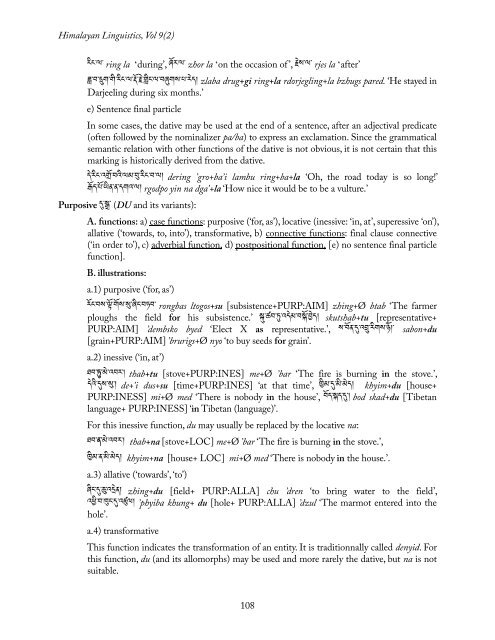The Classical Tibetan cases and their transcategoriality
The Classical Tibetan cases and their transcategoriality
The Classical Tibetan cases and their transcategoriality
You also want an ePaper? Increase the reach of your titles
YUMPU automatically turns print PDFs into web optimized ePapers that Google loves.
Himalayan Linguistics, Vol 9(2)<br />
རིང་ལ་ ring la ‘during’, ཞོར་ལ་ zhor la ‘on the occasion of ’, རྗེས་ལ་ rjes la ‘after’<br />
ཟླ་བ་དྲུག་གི་རིང་ལ་རྡོ་རྗེ་གླིང་ལ་བཞུགས་པ་རེད། zlaba drug+gi ring+la rdorjegling+la bzhugs pared. ‘He stayed in<br />
Darjeeling during six months.’<br />
e) Sentence final particle<br />
In some <strong>cases</strong>, the dative may be used at the end of a sentence, after an adjectival predicate<br />
(often followed by the nominalizer pa/ba) to express an exclamation. Since the grammatical<br />
semantic relation with other functions of the dative is not obvious, it is not certain that this<br />
marking is historically derived from the dative.<br />
དེ་རིང་འགྲོ་བའི་ལམ་བུ་རིང་བ་ལ། dering ’gro+ba’i lambu ring+ba+la ‘Oh, the road today is so long!’<br />
རྒོད་པོ་ཡིན་ན་དགའ་ལ། rgodpo yin na dga’+la ‘How nice it would be to be a vulture.’<br />
Purposive དུ་སྒྲ་ (DU <strong>and</strong> its variants):<br />
A. functions: a) case functions: purposive (‘for, as’), locative (inessive: ‘in, at’, superessive ‘on’),<br />
allative (‘towards, to, into’), transformative, b) connective functions: final clause connective<br />
(‘in order to’), c) adverbial function, d) postpositional function, [e) no sentence final particle<br />
function].<br />
B. illustrations:<br />
a.1) purposive (‘for, as’)<br />
རོང་བས་ལྟོ་གོས་སུ་ཞིང་བཏབ་ rongbas ltogos+su [subsistence+PURP:AIM] zhing+Ø btab ‘<strong>The</strong> farmer<br />
ploughs the field for his subsistence.’ སྐུ་ཚབ་ཏུ་འདེམ་བསྐོ་བྱེད། skutshab+tu [representative+<br />
PURP:AIM] ’dembsko byed ‘Elect X as representative.’, ས་བོན་དུ་འབྲུ་རིགས་ཉོ།་ sabon+du<br />
[grain+PURP:AIM] ’brurigs+Ø nyo ‘to buy seeds for grain’.<br />
a.2) inessive (‘in, at’)<br />
ཐབ་ཏུ་མེ་འབར་། thab+tu [stove+PURP:INES] me+Ø ’bar ‘<strong>The</strong> fire is burning in the stove.’,<br />
དེའི་དུས་སུ་། de+’i dus+su [time+PURP:INES] ‘at that time’, ཁྱིམ་དུ་མི་མེད། khyim+du [house+<br />
PURP:INESS] mi+Ø med ‘<strong>The</strong>re is nobody in the house’, བོད་སྐད་དུ་། bod skad+du [<strong>Tibetan</strong><br />
language+ PURP:INESS] ‘in <strong>Tibetan</strong> (language)’.<br />
For this inessive function, du may usually be replaced by the locative na:<br />
ཐབ་ན་མེ་འབར་། thab+na [stove+LOC] me+Ø ’bar ‘<strong>The</strong> fire is burning in the stove.’,<br />
ཁྱིམ་ན་མི་མེད། khyim+na [house+ LOC] mi+Ø med ‘<strong>The</strong>re is nobody in the house.’.<br />
a.3) allative (‘towards’, ‘to’)<br />
ཞིང་དུ་ཆུ་འདྲེན། zhing+du [field+ PURP:ALLA] chu ’dren ‘to bring water to the field’,<br />
འཕྱི་བ་ཁུང་དུ་འཛུལ། ’phyiba khung+ du [hole+ PURP:ALLA] ’dzul ‘<strong>The</strong> marmot entered into the<br />
hole’.<br />
a.4) transformative<br />
This function indicates the transformation of an entity. It is traditionnally called denyid. For<br />
this function, du (<strong>and</strong> its allomorphs) may be used <strong>and</strong> more rarely the dative, but na is not<br />
suitable.<br />
108
















